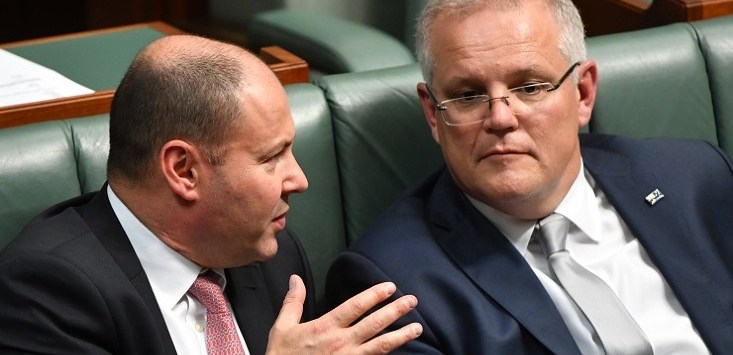
Treasurer Josh Frydenberg and Prime Minister Scott Morrison. Source: AAP/Mick Tsikas.
We are living through a government-supported economic bubble that is cushioning the economy and supporting our recovery through our first recession in 29 years.
So, what happens when the government stimulus ends? Unless there is a change in policy, October is shaping up as the first full month when many key government-funded stimulus programs will cease — creating a range of pressures that will test small and medium businesses.
A moment of truth as four policies end
1. JobKeeper
On September 27, the JobKeeper program, which is paying 3.5 million recipients $1500 per fortnight, will end. More than 910,000 businesses have enrolled in the scheme that has helped them keep employees as revenues fell by more than 30% on last year.
When the $70 billion program ends, recipients will revert to JobSeeker and receive just $1100 per fortnight. This will mean that coronavirus crisis-affected businesses will need to pay their employees without any subsidies from September 28. This will likely trigger an increase in redundancies from October while there will be less consumer spending as a result of more people being unemployed and on the JobSeeker program.
2. Loan repayment deferrals
The major banks have deferred repayments on $224 billion of home and business loans for more than 700,000 individuals and businesses during this crisis. Digital Finance Analytics (DFA) surveys project that more than 1.4 million Australians are in mortgage stress and almost 100,000 are at risk of default when JobKeeper ends. From October, the loan repayment deferrals for individuals and businesses will end creating new pressure on households and businesses who will be required to repay at least the interest on their loans.
3. Rent abatements and deferrals
Landlord abatement and deferrals will be withdrawn over the next few months as revenues rebuild. Unless businesses can negotiate better and more variable terms, they will have to revert to the obligations in their pre-pandemic lease. On top of this, residential eviction moratoriums will no longer exist to protect tenants whose incomes have been affected by the pandemic.
4. Additional childcare subsidies
The additional Early Childhood Education and Care Relief package costing $1.6 billion is expected to end on June 28, which will put further pressure on working families.
Six resets to help businesses survive and thrive
So, with government stimulus ending over the next few months, businesses trying to rebuild revenues will be exposed to pre-pandemic labour, rent and financing expenses. The political pressure to extend the stimulus, beyond the home-building bonus, will be immense. Add less immigration, and lower expenditure on events, travel and tourism and it is looking like a very tough 2021. As a result, we will need to re-imagine our businesses so we survive and thrive with the following six resets.
1. Agile leadership
This crisis has tested the leaders within our businesses. Some have thrived and others have struggled. We have learnt that leaders with a combination of agility, tenacity, curiosity, insight, engagement and vision are best placed to create a new future. Some businesses will need new leadership to re-imagine the business and operate in the post-pandemic environment.
2. Technology transformation
Digital customer behaviours have accelerated through the pandemic, whether it be stronger e-commerce ordering, contactless payments or on-demand delivery services. Businesses will need to review how their technology stack supports business intelligence, automated operations and better customer engagement.
3. Product and customer fit
We may need to reassess our product and customer fit informed by the structural changes in how customers are discovering, searching, buying, paying, acquiring and creating relationships with brands.
4. Variable cost model
We will need to move our cost base from fixed to more variable expenses to allow our businesses to compress costs in line with revenue recovery.
5. Reliable debtors and flexible creditors
We will need to build business with debtors who pay in full and on time while we negotiate terms with creditors that eliminate any funding gaps. The businesses that will survive will generate sales, turn inventory and receive payments before paying for the inventory.
6. Strong liquidity
We will need to build businesses that have no or very low levels of debt to fund the operation and have facilities that can access funding for investing.
The end of government stimulus, planned from October, will create pre-pandemic cost pressures on businesses who are rebuilding revenues. As we re-imagine our businesses into 2021 we may need to reset our leadership, technology stack, product/customer fit, cash flow and liquidity.
NOW READ: JobKeeper verdict in July as Australia prepares for first recession in 29 years


COMMENTS
SmartCompany is committed to hosting lively discussions. Help us keep the conversation useful, interesting and welcoming. We aim to publish comments quickly in the interest of promoting robust conversation, but we’re a small team and we deploy filters to protect against legal risk. Occasionally your comment may be held up while it is being reviewed, but we’re working as fast as we can to keep the conversation rolling.
The SmartCompany comment section is members-only content. Please subscribe to leave a comment.
The SmartCompany comment section is members-only content. Please login to leave a comment.